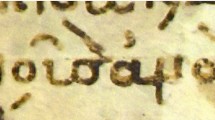Abstract
This article identifies problems and proposes solutions for encoding verse texts in SGML. It is organized around a series of distinctions and oppositions which the TEI Work Group on Verse regard as significant. These include examination of the formal properties which distinguish verse from prose, followed by discussions of (1) text-searching vs analysis, (2) markup vs algorithms, (3) markup vs transcription, (4) uniformity vs choice, (5) specificity vs generality, (6) metrical convention vs linguistic realization, (7) structural vs non-structural divisions and (8) fidelity vs interpretation. Using German and English verse forms as illustrations, the advantages and disadvantages of pre-line tagging, in-line tagging and feature structure analysis are discussed. We suggest that metrical and rhyme conventions always be tagged at the highest possible level of text divisions.
Similar content being viewed by others
References
Chisholm, D. “Phonological Patterning in English and German Verse: A Computer-assisted Approach”.Quantitative Linguistics, 14 (1982), 114–46.
Sperberg-McQueen, C.M. “Text in the Electronic Age: Textual Study and Text Encoding with Examples”.Literary and Linguistic Computing, 6, 1 (1991), 34–46.
Sperberg-McQueen, C.M. and Lou Burnard, eds.Guidelines for Electronic Text Encoding and Interchange (TEI P3). 2 vols. Chicago and Oxford: Text Encoding Initiative, 1994.
Author information
Authors and Affiliations
Additional information
David Chisholm is Professor of German Studies at the University of Arizona. His interests include German lyric poetry and verse drama, metrics and versification, linguistic and computational approaches to literature, and phonological and prosodic aspects of literary style. His publications include “Computer-assisted Research in German Language and Literature” in theGerman Quarterly (1985),Verskonkordanz zu Goethes “Faust, Erster Teil” (with Stephen P. Sondrup, 1986), “Phonological Patterning in Twentieth Century German Verse and Prose” inDescriptio Linguistica (1986) and “Lexicality and the Versification of Johann Heinrich Voss” inInsights in Germanic Linguistics (1994).
David Robey is Professor of Italian at Manchester University and Dean of the Faculty of Arts. He has worked on Italian Renaissance Humanism, modern literary theory (editor and author with Ann Jefferson ofModern Literary Theory: A Comparative Introduction), and on the computer analysis of medieval and Renaissance narrative poetry. He is currently engaged in a metrical study of theDivine Comedy, and was Chair of the Verse Work Group of the Text Encoding Initiative.




